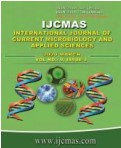


 National Academy of Agricultural Sciences (NAAS)
National Academy of Agricultural Sciences (NAAS)

|
PRINT ISSN : 2319-7692
Online ISSN : 2319-7706 Issues : 12 per year Publisher : Excellent Publishers Email : editorijcmas@gmail.com / submit@ijcmas.com Editor-in-chief: Dr.M.Prakash Index Copernicus ICV 2018: 95.39 NAAS RATING 2020: 5.38 |
A field experiment was conducted to study the effects of plantgrowth regulators and polyamine on yield and quality of litchi cv. China at the Experimental Farm-1, Department of Horticulture, SASRD, Nagaland university, Medziphema Campus, Nagaland during the year 2016-2017 and 2017-2018.The trees were sprayed with Gibberellic Acid @ 40 ppm (T1), Naphthalene Acetic Acid @ 40 ppm (T2), Putrescine @ 1.0 mM/L (T3), Gibberellic Acid @ 40 ppm + Putrescine @ 1.0 mM/L (T4), Naphthalene Acetic Acid @ 40 ppm + Putrescine @ 1.0 mM/L (T5) and water (control: T6) at pea and marble stage using Randomized Block Design comprising of four replications. Among the various treatments, minimum fruit drop percentage (54.32% and 51.07%) was observed by spraying with Naphthalene Acetic Acid @ 40 ppm from fruit set to maturity and as a consequences T2 was found to be effective in increasing the fruit retention (45.68% and 48.93%). T4 proved to be effective in minimizing fruit cracking (2.30 % and 1%) with highest leaf water content (77.77% and 81.77%) while maximum fruit cracking (7.46% and 4.03%) and lowest leaf water content (70.25 % and 71.81%) was found in control. GA3 @ 40 ppm (T1) showed the maximum values of fruit weight with 20.20 g and 21.10 g and aril recovery percentage with 64.36 % and 65.40 % whereas control recorded lowest values of 15.95 g and 16.10 g and 53.48 % and 55.16 % aril respectively. It was also recorded the highest average TSS 17.32ºB, total sugar (10.22 %), ascorbic acid (61.00 mg/100g pulp) and lowest acidity (0.47 %) by spraying of GA3 @ 40 ppm (T1). Maximum anthocyanin content (59.76 mg and 59.86 mg per 100 g peel) in peel and protein content (12.69 % and 13.13 %) in pulp was noticed in Naphthalene Acetic Acid @ 40 ppm (T2) whereas minimum anthocyanin content (40.92 mg and 40.74 mg/100 g peel) in peel and protein content (9.83% and 10.43%) in pulp was recorded in control.
 |
 |
 |
 |
 |